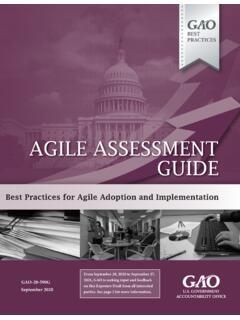Transcription of Open banking and PSD2 - Deloitte
1 How to flourish in an uncertain futureOpen banking and psd2 ContentsForeword 01 Executive summary 02 Chapter 1 Market context 04 Chapter 2 open banking and psd2 07 Chapter 3 Consumers ready for change 13 Chapter 4 How will the retail banking market evolve? 17 Chapter 5 What will incumbents need to do to thrive in an open banking future?
2 24 Conclusion 27 Appendix 28 Endnotes 29 Contacts 31In this publication, references to Deloitte are references to Deloitte LLP, the UK affiliate of Deloitte NWE LLP, a member firm of Deloitte Touche Tohmatsu banking has faced a number of disruptive threats in the past, but each time the traditional banks have adapted and grown stronger.
3 Key events include the introduction of telephone banking in the late 80s and online banking in the 90s, the impact of 2008 s global financial crisis and the more recent FinTech explosion. In addition, a number of new direct banks emerged in both the 80s and 90s, seeking to exploit their lack of a branch network as a competitive cost advantage. Although there were select successes, these new entrants were largely unable to make significant dents in incumbents market of these new developments led some market commentators at the time to predict the imminent demise of banking as we know , while telephone and online banking have caused customers to migratei from the bank branch to new channels, the traditional banking business model arguably remains broadly unchanged.
4 This is despite the great technological advances of recent decades. Retail banks still take deposits and lend money, predominantly earning their revenue from the net interest margin this generates. Banks continue to retain ownership of the customer relationship, and, crucially, of customer data. And FinTechs are yet to make significant inroads into the UK retail banking space. So it would be easy to dismiss all the current talk of disruption in the marketplace. However, we believe it really is different this Because of the potentially significant impact of open banking , driven by regulation and enabled by advances in technology. The phrase open banking ii is used to describe the shift from a closed model to one in which data is shared between different members of the banking ecosystem with authorisation from the open banking demands a fundamental rethink of the traditional banking business model, enabling banking to become more customer-centric.
5 The exchange of customer data looks set to level the playing field between incumbents and new entrants, increasing competition. i The number of branch visits in the UK fell from 476 million in 2011 to 278 million in 2016, while over the same period the number of mobile banking logins increased from 169 million to 1,191 million. The Changing Face of Channel Usage, CACI, 6 July 2016. See also: open banking enables personal customers and small businesses to share their data securely with other banks and third parties, allowing them to compare products on the basis of their own requirements and to manage their accounts without having to use their bank.
6 The Initiative, open banking . See also: more importantly, open banking will facilitate the creation of new products and services that were previously impossible to possibilities are innumerable. In this paper, we explain what open banking really means and lay out scenarios for the future that it will create. The Competition and Markets Authority s (CMA s) open banking initiatives stem from its investigation into personal current accounts, business current accounts and small and medium-sized enterprise (SME) loans. To find out what consumers and SMEs truly want from digital banking , Deloitte has also commissioned YouGov to conduct surveys of both these research shows that the threat to the traditional banking business model is real.
7 But while the threats to incumbent banks are greater than ever, so are the an extreme scenario, some banks could be relegated to the background as infrastructure providers while other entities FinTechs, tech giants and price- comparison websites (PCWs), for example could come to own the customer relationship. As a result, these could potentially become the leading brands in banking without ever taking customer deposits or lending onto their own balance , incumbent banks that embrace open banking to create new sources of revenue and new propositions may enjoy a significant advantage, given their access to existing customers, strong brands and expertise.
8 As a result, incumbent banks have a real opportunity to win the battle for the customer interface and, therefore, the customer future of banking is far from certain. However, we hope this paper will spark a debate. We plan to explore the various implications for banks in further detail throughout the coming welcome your opinions. Neil TomlinsonHead of UK Banking1 How to flourish in an uncertain future | open banking and psd2 Executive summaryUK retail banks have faced headwinds since the global financial crisis. Low growth rates have prompted central banks to slash interest rates, putting pressure on banks margins. More stringent regulatory capital requirements, high remediation provisions and increased ongoing compliance costs have also contributed to a tough backdrop that has caused European banks to earn returns below their cost of equity since 2008.
9 During this period, UK retail banks have also been facing increased competition from innovative financial technology firms ( FinTechs ) focusing on niches within the retail banking value chain. Such firms have been enabled by advances in technology and a favourable UK regulatory stance towards them the same factors that are now facilitating the entry into the market of mobile-only banks looking to compete directly with the s not all. Regulation has been concurrently driving what we believe will bring about a revolution in UK retail banking open banking . In this development, regulators are seeking to drive increased competition and innovation by opening up customer banking data to third parties.
10 This is taking place at two levels: across the EU, in the form of the revised Payment Services Directive ( psd2 ) in the UK, with the Competition and Markets Authority (CMA) mandating the UK s largest banks to adopt the open banking up bank data carries an inherent threat of commoditisation for incumbent banks. This is because it potentially enables third parties to own the primary customer relationship, by allowing accounts from different providers to be accessed via a single interface that isn t necessarily owned by an incumbent. It also potentially heightens competition by enabling more personalised comparisons between accounts held at different , incumbents are also in a position to enhance customer loyalty and engagement by harnessing this additional data to provide, for example, a more personalised customer experience and develop innovative new propositions.















